Here are some new resources and news for the field of higher education.
Iowa high-schoolers most likely in U.S. to be taking college classes. Iowa leads the nation in providing college-level coursework for its high school students, according to a state education department report. More than 44,000 Iowa high-schoolers were taking a community college class for credit in 2014. (Daily Nonpareil, April 30).
Moving from single to multiple measures for college course placement. A slow but steady movement is emerging to rethink—and revise—the single test, single cut score approach that sorts new college students into remedial or credit-level courses. The latest blog post on Ed Note explores how several states and post-secondary systems are beginning to use additional indicators to gauge students’ college readiness.
White House push on free community college: The Obama administration unveiled a $100 million grant competition program to help community colleges create tuition-free education and job training programs in partnership with their business communities. (Inside Higher Ed, April 26).
Toward Convergence: A Technical Guide for the Postsecondary Metrics Framework. While the evidence supports that a college degree is essential to economic success and social mobility in the 21st century, especially for low-income students and students of color, many speculate about the value and outcomes of specific programs and institutions. The information available today is inadequate and leaves the public wondering about answers to key questions about college access, progression, completion, cost, and outcomes. (Source: Institute for Higher Education Policy).
2016 College Affordability Diagnosis (Institute for Research on Higher Education). This report contends that the converging trends of falling state investment, rising tuition, and stagnant incomes have finally pushed higher education out of the grasp of low- and middle-income Americans, even at community colleges.

